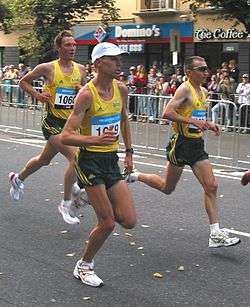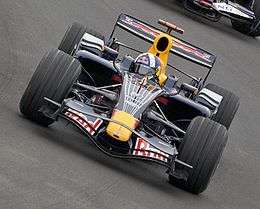Marathon
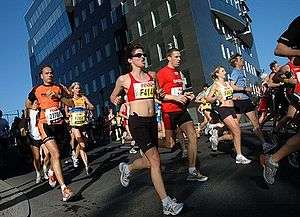
The marathon is a long-distance running event with an official distance of 42.195 kilometres (26.219 miles, or 26 miles 385 yards),[1] usually run as a road race. The event was instituted in commemoration of the fabled run of the Greek soldier Pheidippides (more correctly, Philippides), a messenger from the Battle of Marathon to Athens, who reported the victory.
The marathon was one of the original modern Olympic events in 1896, though the distance did not become standardized until 1921. More than 500 marathons are held throughout the world each year, with the vast majority of competitors being recreational athletes as larger marathons can have tens of thousands of participants.[2]
History
Origin

The name Marathon[n 1] comes from the legend of Philippides or Pheidippides, the Greek messenger. The legend states that he was sent from the battlefield of Marathon to Athens to announce that the Persians had been defeated in the Battle of Marathon (in which he had just fought),[3] which took place in August or September, 490 BC.[4] It is said that he ran the entire distance without stopping and burst into the assembly, exclaiming νενικήκαμεν (nenikēkamen, "we have won!"), before collapsing and dying.[5] The account of the run from Marathon to Athens first appears in Plutarch's On the Glory of Athens in the 1st century AD, which quotes from Heraclides Ponticus's lost work, giving the runner's name as either Thersipus of Erchius or Eucles.[6] Lucian of Samosata (2nd century AD) also gives the story, but names the runner Philippides (not Pheidippides).[7]
There is debate about the historical accuracy of this legend.[8][9] The Greek historian Herodotus, the main source for the Greco-Persian Wars, mentions Philippides as the messenger who ran from Athens to Sparta asking for help, and then ran back, a distance of over 240 kilometres (150 mi) each way.[10] In some Herodotus manuscripts, the name of the runner between Athens and Sparta is given as Philippides. Herodotus makes no mention of a messenger sent from Marathon to Athens, and relates that the main part of the Athenian army, having fought and won the grueling battle, and fearing a naval raid by the Persian fleet against an undefended Athens, marched quickly back from the battle to Athens, arriving the same day.[11]
In 1879, Robert Browning wrote the poem Pheidippides. Browning's poem, his composite story, became part of late 19th century popular culture and was accepted as a historic legend.[12]
There are two roads out of the battlefield of Marathon towards Athens, one more mountainous towards the north whose distance is about 34.5 km (21.4 mi), and another flatter but longer towards the south with a distance of 40.8 km (25.4 mi). It has been argued that the ancient runner took the more difficult northern road because at the time of the battle there were still Persian soldiers in the south of the plain.
Mount Penteli stands between Marathon and Athens, which means that, if Philippides actually made his famous run after the battle, he had to run around the mountain, either to the north or to the south. The latter and more obvious route matches almost exactly the modern Marathon-Athens highway, which follows the lie of the land southwards from Marathon Bay and along the coast, then takes a gentle but protracted climb westwards towards the eastern approach to Athens, between the foothills of Mounts Hymettus and Penteli, and then gently downhill to Athens proper. This route, as it existed when the Olympics were revived in 1896, was approximately 40 kilometres (25 mi) long, and this was the approximate distance originally used for marathon races. However, there have been suggestions that Philippides might have followed another route: a westward climb along the eastern and northern slopes of Mount Penteli to the pass of Dionysos, and then a straight southward downhill path to Athens. This route is considerably shorter, some 35 kilometres (22 mi), but includes a very steep initial climb of more than 5 kilometres (3.1 mi).
Modern Olympics marathon
When the modern Olympics began in 1896, the initiators and organizers were looking for a great popularizing event, recalling the ancient glory of Greece. The idea of a marathon race came from Michel Bréal, who wanted the event to feature in the first modern Olympic Games in 1896 in Athens. This idea was heavily supported by Pierre de Coubertin, the founder of the modern Olympics, as well as by the Greeks. The Greeks staged a selection race for the Olympic marathon on 10 March 1896 (Julian) that was won by Charilaos Vasilakos in 3 hours and 18 minutes (with the future winner of the introductory Olympic Games marathon, Spyridon "Spyros" Louis, coming in fifth). The winner of the first Olympic marathon, on 10 April 1896 (a male-only race), was Spyridon Louis, a Greek water-carrier, in 2 hours 58 minutes and 50 seconds. The marathon of the 2004 Summer Olympics was run on the traditional route from Marathon to Athens, ending at Panathinaiko Stadium, the venue for the 1896 Summer Olympics. That men's marathon was won by Italian Stefano Baldini in 2 hours 10 minutes and 55 seconds, a record time for this route until the non-Olympics Athens Classic Marathon of 2014, when Felix Kandie lowered the course record to 2 hours 10 minutes and 37 seconds.
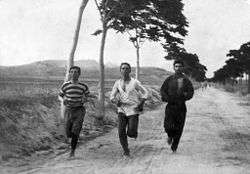
The women's marathon was introduced at the 1984 Summer Olympics (Los Angeles, USA) and was won by Joan Benoit of the United States with a time of 2 hours 24 minutes and 52 seconds.[15]
It has become a tradition for the men's Olympic marathon to be the last event of the athletics calendar, on the final day of the Olympics.[16] For many years the race finished inside the Olympic stadium; however, at the 2012 London games, the start and finish were on The Mall,[17] and at the 2016 Rio games, the start and finish were in the Sambódromo, the parade area that serves as a spectator mall for Carnival.[18]
Often, the men's marathon medals are awarded during the closing ceremony (including the 2004 games, 2012 games and 2016 games).
The Olympic men's record is 2:06:32, set at the 2008 Summer Olympics by Samuel Kamau Wanjiru of Kenya[19] (average speed about 20.01 kilometres per hour or 12.43 miles per hour). The Olympic women's record is 2:23:07, set at the 2012 Summer Olympics by Tiki Gelana of Ethiopia.[20] The men's London 2012 Summer Olympic marathon winner was Stephen Kiprotich of Uganda (2:08:01). Per capita, the Kalenjin ethnic group of Rift Valley Province in Kenya has produced a highly disproportionate share of marathon and track-and-field winners.
Marathon mania
Johnny Hayes' victory at the 1908 Summer Olympics contributed to the early growth of long-distance running and marathoning in the United States.[21][22] Later that year, races around the holiday season including the Empire City Marathon held on New Year's Day 1909 in Yonkers, New York, marked the early running craze referred to as "marathon mania".[23] Following the 1908 Olympics, the first five amateur marathons in New York City were held on days that held special meanings to ethnic communities: Thanksgiving Day, the day after Christmas, New Year's Day, Washington's Birthday, and Lincoln's Birthday.[24]
Frank Shorter's victory in the marathon at the 1972 Summer Olympics would spur national enthusiasm for the sport more intense than that which followed Hayes' win 64 years earlier.[22] By 2009, an estimated 467,000 runners completed a marathon within the United States.[25] This can be compared to 143,000 in 1980. Today marathons are held all around the world on a nearly weekly basis.[26]
Inclusion of women
For a long time after the Olympic marathon started, there were no long-distance races, such as the marathon, for women. Although a few women had run the marathon distance, they were not included in any official results.[27] Marie-Louise Ledru has been credited as the first woman to race a marathon.[28][29][30] Violet Piercy has been credited as the first woman to be officially timed in a marathon.[27] Arlene Pieper became the first woman to officially finish a marathon in the United States when she completed the Pikes Peak Marathon in Manitou Springs, Colorado, in 1959.[31][32] Kathrine Switzer was the first woman to run the Boston Marathon "officially" (with a number).[33] However, Switzer's entry, which was accepted through an "oversight" in the screening process, was in "flagrant violation of the rules", and she was treated as an interloper once the error was discovered.[34] Bobbi Gibb had completed the Boston race unofficially the previous year (1966),[35] and was later recognized by the race organizers as the women's winner for that year, as well as 1967 and 1968.[36] In 2015 Afghanistan held its first marathon; among those who ran the entire marathon was one woman, Zainab, age 25, who thus became the first Afghan woman to run in a marathon within her own country.[37]
Distance
|
Olympic marathon distances | ||
| Year | Distance (km) |
Distance (miles) |
|---|---|---|
| 1896 | 40 | 24.85 |
| 1900 | 40.26 | 25.02 |
| 1904 | 40 | 24.85 |
| 1906 | 41.86 | 26.01 |
| 1908 | 42.195 | 26.22 |
| 1912 | 40.2 | 24.98 |
| 1920 | 42.75 | 26.56 |
| 1924 onward | 42.195 | 26.22 |
The length of an Olympic marathon was not precisely fixed at first, but the marathon races in the first few Olympic Games were about 40 kilometres (25 mi),[38] roughly the distance from Marathon to Athens by the longer, flatter route. The exact length depended on the route established for each venue.
1908 Olympics
The International Olympic Committee agreed in 1907 that the distance for the 1908 London Olympic marathon would be about 25 miles or 40 kilometres. The organisers decided on a course of 26 miles from the start at Windsor Castle to the royal entrance to the White City Stadium, followed by a lap (586 yards 2 feet; 536 m) of the track, finishing in front of the Royal Box.[39][40] The course was later altered to use a different entrance to the stadium, followed by a partial lap of 385 yards to the same finish.
The modern 42.195 km standard distance for the marathon was set by the International Amateur Athletic Federation (IAAF) in May 1921[41][42][43][44] directly from the length used at the 1908 Summer Olympics in London.
IAAF and world records
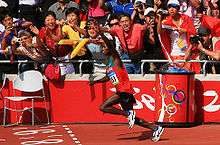
An official IAAF marathon course is 42.195 km (42 m tolerance only in excess).[45] Course officials add a short course prevention factor of up to one metre per kilometre to their measurements to reduce the risk of a measuring error producing a length below the minimum distance.
For events governed by IAAF rules, it is mandatory that the route be marked so that all competitors can see the distance covered in kilometres.[1] The rules make no mention of the use of miles. The IAAF will only recognise world records that are established at events that are run under IAAF rules. For major events, it is customary to publish competitors' timings at the midway mark and also at 5 km splits; marathon runners can be credited with world records for lesser distances recognised by the IAAF (such as 20 km, 30 km and so on) if such records are established while the runner is running a marathon, and completes the marathon course.[46]
Marathon races
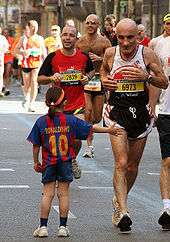
Annually, more than 500 marathons are organized worldwide.[2] Some of these belong to the Association of International Marathons and Distance Races (AIMS) which has grown since its foundation in 1982 to embrace over 300 member events in 83 countries and territories.[47] The marathons of Berlin, Boston, Chicago, London, New York City and Tokyo form the biennial World Marathon Majors series, awarding $500,000 annually to the best overall male and female performers in the series.
In 2006, the editors of Runner's World selected a "World's Top 10 Marathons",[48] in which the Amsterdam, Honolulu, Paris, Rotterdam, and Stockholm marathons were featured along with the five original World Marathon Majors events (excluding Tokyo). Other notable large marathons include United States Marine Corps Marathon, Los Angeles, and Rome. The Boston Marathon is the world's oldest annual marathon, inspired by the success of the 1896 Olympic marathon and held every year since 1897 to celebrate Patriots Day, a holiday marking the beginning of the American Revolution, thereby purposely linking Athenian and American struggle for democracy.[49] The oldest annual marathon in Europe is the Košice Peace Marathon, held since 1924 in Košice, Slovakia. The historic Polytechnic Marathon was discontinued in 1996. The Athens Classic Marathon traces the route of the 1896 Olympic course, starting in Marathon on the eastern coast of Attica, site of the Battle of Marathon of 490 B.C.E., and ending at the Panathenaic Stadium in Athens.[50]
The Midnight Sun Marathon is held in Tromsø, Norway at 70 degrees north. Using unofficial and temporary courses, measured by GPS, races of marathon distance are now held at the North Pole, in Antarctica and over desert terrain. Other unusual marathons include the Great Wall Marathon on The Great Wall of China, the Big Five Marathon among the safari wildlife of South Africa, the Great Tibetan Marathon – a marathon in an atmosphere of Tibetan Buddhism at an altitude of 3,500 metres (11,500 ft), and the Polar Circle Marathon on the permanent ice cap of Greenland.
The Intercontinental Istanbul Eurasia Marathon is the only marathon where participants run over two continents (Europe and Asia) during the course of a single event. In the Detroit Free Press Marathon, participants cross the US/Canada border twice.[51] The Niagara Falls International Marathon includes one international border crossing, via the Peace Bridge from Buffalo, New York, United States to Fort Erie, Ontario, Canada.
Wheelchair division
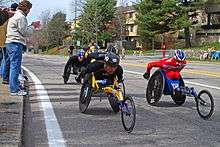
Many marathons feature a wheelchair division. Typically, those in the wheelchair racing division start their races earlier than their running counterparts.
The first wheelchair marathon was in 1974 in Toledo, Ohio, won by Bob Hall in 2:54.[52][53] Hall competed in the 1975 Boston Marathon and finished in 2:58, inaugurating the introduction of wheelchair divisions into the Boston Marathon.[54][55] From 1977 the race was declared the US National Wheelchair championship.[56] The Boston Marathon awards $10,000 to the winning push-rim athlete.[57] Ernst van Dyk has won the Boston Marathon wheelchair division ten times and holds the world record at 1:18:27, set in Boston in 2004.[58] Jean Driscoll won eight times (seven consecutively) and holds the women's world record at 1:34:22.[59]
The New York City Marathon banned wheelchair entrants in 1977, citing safety concerns, but then voluntarily allowed Bob Hall to compete after the state Division of Human Rights ordered the marathon to show cause.[60][61] The Division ruled in 1979 that the New York City Marathon and New York Road Runners club had to allow wheelchair athletes to compete, and confirmed this at appeal in 1980,[62] but the State Supreme Court ruled in 1981 that a ban on wheelchair racers was not discriminatory as the marathon was historically a foot race.[63] However, by 1986 14 wheelchair athletes were competing,[64] and an official wheelchair division was added to the marathon in 2000.[57]The first person to complete a marathon in a robotic walking device was Claire Lomas (UK) wNo completed the 2012 Virgin London Marathon in sixteen days.[65]
Some of the quickest people to complete a wheel-chair marathon include Thomas Geierpichler (Austria) who won gold in men's T52-class marathon (no lower li,b function) in 1 hr 49 min 7 sec in Beijing China, on September 17 2008; and, Heinz Frei (Switzerland) who won the men's T54 marathon (for racers with spinal cord injuries) in a time of 1 hr 20 min and 14 sec in Oita, Japan, October 31 1999.[66]
Statistics
World records and world's best
World records were not officially recognized by the IAAF until 1 January 2004; previously, the best times for the marathon were referred to as the 'world best'. Courses must conform to IAAF standards for a record to be recognized. However, marathon routes still vary greatly in elevation, course, and surface, making exact comparisons impossible. Typically, the fastest times are set over relatively flat courses near sea level, during good weather conditions and with the assistance of pacesetters.
The current world record time for men over the distance is 2 hours 2 minutes and 57 seconds, set in the Berlin Marathon by Dennis Kimetto of Kenya on 28 September 2014,[67] an improvement of 26 seconds over the previous record also set in the Berlin Marathon by Wilson Kipsang, also of Kenya on 29 September 2013.[68] The world record for women was set by Paula Radcliffe of Great Britain in the London Marathon on 13 April 2003, in 2 hours 15 minutes and 25 seconds.[69]
All-time lists
According to the IAAF, the following men and women are the top 25 fastest at the marathon distance (updated 25 September 2016).[70][71]
Notes
|
Notes
|
Oldest marathoner
Fauja Singh, then 100, finished the Toronto Waterfront Marathon, becoming the first centenarian ever to officially complete that distance. Singh, a British citizen, finished the race on 16 October 2011 with a time of 8:11:05.9, making him the oldest marathoner.[73] Because Singh could not produce a birth certificate from rural 1911 Colonial India, the place of his birth, his age could not be verified and his record was not accepted by the official governing body World Masters Athletics.
Gladys Burrill, a 92-year-old Prospect, Oregon woman and part-time resident of Hawaii, previously held the Guinness World Records title of oldest person to complete a marathon with her 9 hours 53 minutes performance at the 2010 Honolulu Marathon.[74][75] The records of the Association of Road Racing Statisticians, at that time, however, suggested that Singh was overall the oldest marathoner, completing the 2004 London Marathon at the age of 93 years and 17 days, and that Burrill was the oldest female marathoner, completing the 2010 Honolulu Marathon at the age of 92 years and 19 days.[76] Singh's age was also reported to be 93 by other sources.[77][78]
In 2015, 92-yr-old Harriette Thompson of Charlotte, North Carolina, completed the Rock 'n' Roll San Diego Marathon in 7 hours 24 minutes 36 seconds, thus becoming the oldest woman to complete a marathon.[79] While Gladys Burrill was 92 years and 19 days old when she completed her record-setting marathon, Harriette Thompson was 92 years and 65 days old when she completed hers.[79]
Youngest marathoner
Budhia Singh, a boy from Odisha, India, completed his first marathon at age three. He trained under the coach Biranchi Das, who saw potential in him. In May 2006, Budhia was temporarily banned from running by the ministers of child welfare, as his life could be at risk. His coach was also arrested for exploiting and cruelty to a child. Budhia is now at a state-run sports academy.[80]
Participation
In 2011, Running USA reported that there were approximately 518,000 marathon finishers in the United States,[81] while other sources reported around 550,000 finishers.[82]
Multiple marathons
As marathon running has become more popular, some athletes have undertaken challenges involving running a series of marathons.
The 100 Marathon Club is intended to provide a focal point for all runners, particularly from the United Kingdom or Ireland, who have completed 100 or more races of marathon distance or longer. At least 10 of these events must be United Kingdom or Ireland Road Marathons.[83] Club chairman Roger Biggs has run more than 700 marathons or ultras. Brian Mills completed his 800th marathon on 17 September 2011.
Steve Edwards, a member of the 100 Marathon Club, set the world record for running 500 marathons in the fastest average finish time of 3 hours 15 minutes, at the same time becoming the first man to run 500 marathons with an official time below 3 hours 30 minutes, on 11 November 2012 at Milton Keynes, England. The records took 24 years to achieve. Edwards was 49 at the time.[84]
Over 350 individuals have completed a marathon in each state of the United States plus Washington, D.C. and some have done it as many as eight times.[85] Beverly Paquin, a 22-year-old nurse from Iowa, was the youngest woman to run a marathon in all 50 states in 2010.[86] A few weeks later, still in 2010, Morgan Cummings (also 22) became the youngest woman to complete a marathon in all 50 states and DC.[87] In 2004, Chuck Bryant of Miami, Florida, who lost his right leg below the knee, became the first amputee to finish this circuit.[88] Bryant has completed a total of 59 marathons on his prosthesis. Twenty-seven people have run a marathon on each of the seven continents, and 31 people have run a marathon in each of the Canadian provinces. In 1980, in what was termed the Marathon of Hope, Terry Fox, who had lost a leg to cancer and so ran with one artificial leg, attained 5,373 kilometres (3,339 mi) of his proposed cross-Canada cancer fundraising run, maintaining an average of over 37 kilometres (23 mi), close to the planned marathon distance, for each of 143 consecutive days.[89]
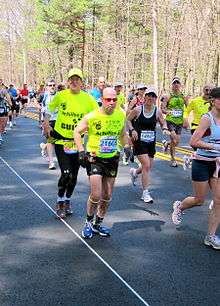
On 25 September 2011, Patrick Finney of Grapevine, Texas became the first person with multiple sclerosis to finish a marathon in each state of the United States. In 2004, "the disease had left him unable to walk. But unwilling to endure a life of infirmity, Finney managed to regain his ability to balance on two feet, to walk – and eventually to run – through extensive rehabilitation therapy and new medications."[90]
In 2003 British adventurer Sir Ranulph Fiennes completed seven marathons on seven continents in seven days.[91] He completed this feat despite suffering from a heart attack and undergoing a double heart bypass operation just four months before.[92] This feat has since been eclipsed by Irish ultramarathon runner Richard Donovan who in 2009 completed seven marathons on seven continents in under 132 hours (five and a half days).[93] Starting 1 February 2012 he improved on this by completing the 7 on 7 in under 120 hours or in less than five days.[94][95]
On 30 November 2013, 69-year-old Larry Macon set a Guinness World Record for Most Marathons Run in a Year by Man by running 238 marathons. Larry Macon celebrated his 1,000th career marathon at the Cowtown Marathon in Ft. Worth on 24 February 2013.[96]
Other goals are to attempt to run marathons on a series of consecutive weekends (Richard Worley on 159 weekends),[97] or to run the most marathons during a particular year or the most in a lifetime. A pioneer in running multiple marathons was Sy Mah of Toledo, Ohio, who ran 524 before he died in 1988.[98] As of 30 June 2007, Horst Preisler of Germany had successfully completed 1214 marathons plus 347 ultramarathons, a total of 1561 events at marathon distance or longer.[99] Sigrid Eichner, Christian Hottas and Hans-Joachim Meyer have also all completed over 1000 marathons each.[100] Norm Frank of the United States is credited with 945 marathons.[101]
Christian Hottas is meanwhile the first runner who ever completed 2000 marathons. He ran his 2000th at TUI Marathon Hannover on 5 May 2013 together with a group of more than 80 friends from 11 countries, including 8 officers from the 100 Marathons Clubs U.K., North-America, Germany, Denmark, Austria and Italy.[102]
In 2010, Stefaan Engels, a Belgian, set out to run the marathon distance every day of the year. Because of an injury he had to resort to a handbike near the end of January 2010. However, on 5 February he was fully recovered and decided to reset the counter back to zero.[103] On 30 March he broke the existing record of Akinori Kusuda, from Japan, who completed 52 marathons in a row in 2009. As of 5 February 2011, Engels had run 365 marathon distances in as many days.[104] Ricardo Abad Martínez, from Spain, later ran 150 marathons in 150 consecutive days in 2009,[105] and subsequently 500 marathons in a row, from October 2010 to February 2012.[106]
In 2014 Amy Hughes, from England, ran 53 marathons in 53 days, thus setting the record for the most marathons run on consecutive days by any person, male or female.[107]
Some runners compete to run the same marathons for the most consecutive years. For example, Johnny Kelley completed 61 Boston Marathons.[108] Currently, the longest consecutive streak of Boston Marathon finishes—45 in a row—is held by Bennett Beach, of Bethesda, Maryland.[109]
Olympic medalists
Men
Women
World Championships medalists
Men
Women
Running

Most participants do not run a marathon to win. More important for most runners is their personal finish time and their placement within their specific gender and age group, though some runners just want to finish. Strategies for completing a marathon include running the whole distance[113] and a run–walk strategy.[3] In 2005, the average marathon time in the U.S. was 4 hours 32 minutes 8 seconds for men, 5 hours 6 minutes 8 seconds for women.[114]
A goal many runners aim for is to break certain time barriers. For example, recreational first-timers often try to run the marathon under four hours; more competitive runners may attempt to finish under three hours.[115] Other benchmarks are the qualifying times for major marathons. The Boston Marathon, the oldest marathon in the United States, requires a qualifying time for all non-professional runners.[116] The New York City Marathon also requires a qualifying time for guaranteed entry, at a significantly faster pace than Boston's.[117]
Typically, there is a maximum allowed time of about six hours after which the marathon route is closed, although some larger marathons keep the course open considerably longer (eight hours or more). Many marathons around the world have such time limits by which all runners must have crossed the finish line. Anyone slower than the limit will be picked up by a sweeper bus. In many cases the marathon organizers are required to reopen the roads to the public so that traffic can return to normal.
With the growth in popularity of marathoning, many marathons across the United States and the world have been filling to capacity faster than ever before. When the Boston Marathon opened up registration for its 2011 running, the field capacity was filled within eight hours.[118]
Training

The long run is an important element in marathon training.[119] Recreational runners commonly try to reach a maximum of about 32 km (20 mi) in their longest weekly run and a total of about 64 km (40 mi) a week when training for the marathon, but wide variability exists in practice and in recommendations. More experienced marathoners may run a longer distance during the week. Greater weekly training mileages can offer greater results in terms of distance and endurance, but also carry a greater risk of training injury.[120] Most male elite marathon runners will have weekly mileages of over 160 km (100 mi).[120] It is recommended that those new to running should get a checkup from their doctor, as there are certain warning signs and risk factors that should be evaluated before undertaking any new workout program, especially marathon training.[121]
Many training programs last a minimum of five or six months, with a gradual increase in the distance run and finally, for recovery, a period of tapering in the weeks preceding the race. For beginners wishing to merely finish a marathon, a minimum of four months of running four days a week is recommended.[122][123] Many trainers recommend a weekly increase in mileage of no more than 10%. It is also often advised to maintain a consistent running program for six weeks or so before beginning a marathon training program, to allow the body to adapt to the new stresses.[124] The marathon training program itself would suppose variation between hard and easy training, with a periodization of the general plan.[125]
Training programs can be found at the websites of Runner's World,[126] Hal Higdon,[113] Jeff Galloway,[3] and the Boston Athletic Association,[127] and in numerous other published sources, including the websites of specific marathons.
The last long training run might be undertaken up to two weeks prior to the event. Many marathon runners also "carbo-load" (increase carbohydrate intake while holding total caloric intake constant) during the week before the marathon to allow their bodies to store more glycogen.
Glycogen and "the wall"

Carbohydrates that a person eats are converted by the liver and muscles into glycogen for storage. Glycogen burns rapidly to provide quick energy. Runners can store about 8 MJ or 2,000 kcal worth of glycogen in their bodies, enough for about 30 km/18–20 miles of running. Many runners report that running becomes noticeably more difficult at that point.[128] When glycogen runs low, the body must then obtain energy by burning stored fat, which does not burn as readily. When this happens, the runner will experience dramatic fatigue and is said to "hit the wall". The aim of training for the marathon, according to many coaches,[129] is to maximize the limited glycogen available so that the fatigue of the "wall" is not as dramatic. This is accomplished in part by utilizing a higher percentage of energy from burned fat even during the early phase of the race, thus conserving glycogen.
Carbohydrate-based "energy gels" are used by runners to avoid or reduce the effect of "hitting the wall", as they provide easy to digest energy during the run. Energy gels usually contain varying amounts of sodium and potassium and some also contain caffeine. They need to be consumed with a certain amount of water. Recommendations for how often to take an energy gel during the race range widely.[129]

Alternatives to gels include various forms of concentrated sugars, and foods high in simple carbohydrates that can be digested easily. Many runners experiment with consuming energy supplements during training runs to determine what works best for them. Consumption of food while running sometimes makes the runner sick. Runners are advised not to ingest a new food or medicine just prior to or during a race.[129] It is also important to refrain from taking any of the non-steroidal anti-inflammatory class of pain relievers (NSAIDs, e.g., aspirin, ibuprofen, naproxen), as these drugs may change the way the kidneys regulate their blood flow and may lead to serious kidney problems, especially in cases involving moderate to severe dehydration. NSAIDS block the COX-2 enzyme pathway to prevent the production of prostaglandins. These prostaglandins may act as inflammation factors throughout the body, but they also play a crucial role in maintenance of water retention. In less than 5% of the whole population that take NSAIDS, individuals may be more negatively sensitive to renal prostaglandin synthesis inhibition.[130]
After a marathon
Marathon participation may result in various medical, musculoskeletal, and dermatological complaints.[131] Delayed onset muscle soreness (DOMS) is a common condition affecting runners during the first week following a marathon.[132] Various types of mild exercise or massage have been recommended to alleviate pain secondary to DOMS.[132] Dermatological issues frequently include "jogger's nipple", "jogger's toe", and blisters.[133]
The immune system is reportedly suppressed for a short time. Changes to the blood chemistry may lead physicians to mistakenly diagnose heart malfunction.
After long training runs and the marathon itself, consuming carbohydrates to replace glycogen stores and protein to aid muscle recovery is commonly recommended. In addition, soaking the lower half of the body for approximately 20 minutes in cold or ice water may force blood through the leg muscles to speed recovery.[134]
Health risks
Marathon running has various health risks.[135] Training and the races themselves put runners under stress. While rare, even death is a possibility during a race.
Common health risks include injury such as tendonitis, fatigue, knee or ankle sprain, extreme dehydration (electrolyte imbalance), and other conditions. Many are categorised as overuse injuries.
Cardiac health
A study published in 1996[136] found that the risk of a fatal heart attack during or up to 24 hours after a marathon was approximately 1 in 50,000 over an athlete's racing career[137]—which the authors characterised as an "extremely small" risk. The paper went on to say that since the risk was so small, cardiac screening programs for marathons were not warranted. However, this study was not an attempt to assess the overall benefit or risk to cardiac health of marathon running.
In 2006, a study of 60 non-elite marathon participants tested runners for certain proteins (see Troponin) which indicate heart damage or dysfunction after they had completed the marathon, and gave them ultrasound scans before and after the race. The study revealed that, in that sample of 60 people, runners who had done less than 56 km (35 mi) per week of training before the race were most likely to show some heart damage or dysfunction, while runners who had done more than 72 km (45 mi) per week of training beforehand showed few or no heart problems.
According to a study presented in 2010, running a marathon can result in decreased function of more than half the segments in the heart's main pumping chamber, but other parts of the heart will take over. Full recovery is reached within three months or less. The fitter the runner the less the effect.[138]
Water consumption dangers
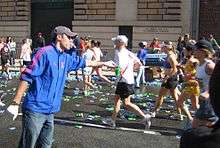
Overconsumption is the most significant concern associated with water consumption during marathons. Drinking excessive amounts of fluid during a race can lead to dilution of sodium in the blood, a condition called exercise-associated hyponatremia, which may result in vomiting, seizures, coma and even death.[139] Dr. Lewis G. Maharam, medical director for the New York City Marathon, has stated, "There are no reported cases of dehydration causing death in the history of world running, but there are plenty of cases of people dying of hyponatremia."[140]
For example, Dr. Cynthia Lucero died at the age of 28 while participating in the 2002 Boston Marathon. It was Lucero's second marathon.[141] At mile 22, Lucero complained of feeling "dehydrated and rubber-legged."[142] She soon wobbled and collapsed to the ground, and was unconscious by the time the paramedics reached her. Lucero was admitted to Brigham and Women's Hospital and died two days later.[143]
Lucero's cause of death was determined to be hyponatremic encephalopathy, a condition that causes swelling of the brain due to an imbalance of sodium in the blood known as exercise-associated hyponatremia (EAH). While EAH is sometimes referred to as "water intoxication," Lucero drank large amounts of Gatorade during the race,[144][145] demonstrating that runners who consume sodium-containing sports drinks in excess of thirst can still develop EAH.[144][144][146] Because hyponatremia is caused by excessive water retention, and not just loss of sodium, consumption of sports drinks or salty foods may not prevent hyponatremia.[147]
Women are more prone to hyponatremia than men. A study in the New England Journal of Medicine found that 13% of runners completing the 2002 Boston Marathon had hyponatremia.[148]
Fluid intake should be adjusted individually as factors such as body weight, sex, climate, pace, fitness (VO2 max), and sweat rate are just a few variables that change fluid requirements between people and races. The International Marathon Medical Directors Association (IMMDA) advises that runners drink a sports drink that includes carbohydrates and electrolytes instead of plain water and that runners should "drink to thirst" instead of feeling compelled to drink at every fluid station.[149] Heat exposure leads to diminished thirst drive and thirst may not be a sufficient incentive to drink in many situations.[150] The IMMDA and HSL Harpur Hill give recommendations to drink fluid in small volumes frequently at an approximate rate falling between 100–250 ml (3.4–8.5 US fl oz) every 15 minutes.[150][149] A patient suffering hyponatremia can be given a small volume of a concentrated salt solution intravenously to raise sodium concentrations in the blood. Some runners weigh themselves before running and write the results on their bibs. If anything goes wrong, first aid workers can use the weight information to tell if the patient had consumed too much water.
Charity involvement
Some charities seek to associate with various races. Some marathon organizers set aside a portion their limited entry slots for charity organizations to sell to members in exchange for donations. Runners are given the option to sign up to run particular races, especially when marathon entries are no longer available to the general public.
In some cases, charities organize their own marathon as a fund-raiser (gaining funds via entry fees or through sponsorships).
Mars rover marathon
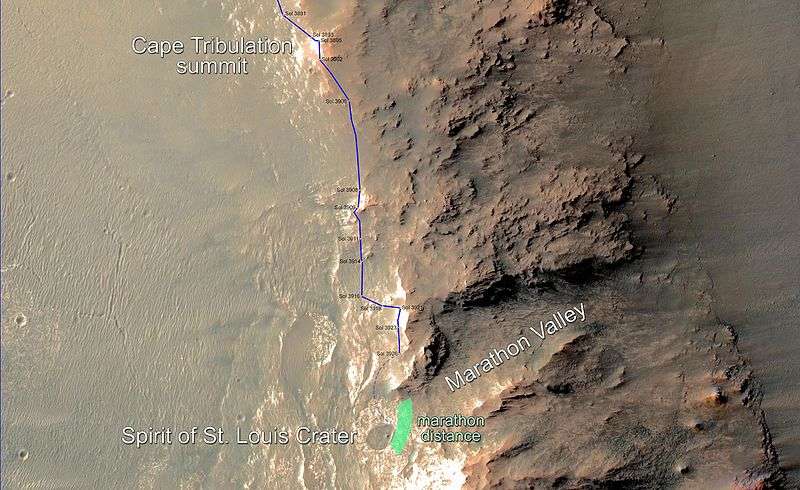
In 2015 the Mars rover Opportunity attained the distance of a marathon from its starting location on Mars, and the valley where it achieved this distance was called Marathon Valley, which was then explored.
See also
- List of marathon races
- Ekiden (marathon relays)
- List of marathoners
- List of marathoners who are non-running specialists
- National records in the marathon
- List of marathon national champions (men)
- Marathon at the Paralympics
- Marathon world record progression
- Half marathon
- Man versus Horse Marathon
- Mountain marathon
- Multiday race
- Ironman Triathlon
- Ski marathon
- 100 Marathon Club
Notes and references
- Notes
- ↑ In modern Greek the sports event is called Marathonios Dromos (Μαραθώνιος Δρόμος) or simply Marathonios.
- References
- 1 2 "IAAF Competition Rules for Road Races". International Association of Athletics Federations. International Association of Athletics Federations. 2009. Retrieved 1 November 2010.
- 1 2 the Marathon race directory. Marathon-world.com (1 December 2006). Retrieved on 19 April 2011.
- 1 2 3 "Retreats — Athens". Jeffgalloway.com. Retrieved 22 August 2009.
- ↑ The Moon and the Marathon, Sky & Telescope. Skytonight.com (19 July 2004). Retrieved on 18 April 2013.
- ↑ "Ancient Olympics FAQ 10". Perseus.tufts.edu. Retrieved 22 August 2009.
- ↑ Moralia 347C
- ↑ A slip of the tongue in Salutation, Chapter 3
- ↑ "Prologue: The Legend". Marathonguide.com. Retrieved 22 August 2009.
- ↑ Holland, Tom (2007) Persian Fire, Knopf Doubleday Publishing Group, ISBN 0307386988.
- ↑ "The Great Marathon Myth". Coolrunning.co.nz. Retrieved 22 August 2009.
- ↑ Herodotus, The Histories Herodotus makes no mention of a runner following the battle runner, and such a runner is mentioned only in much later sources, Nowadays the story of the "Marathon runner" is generally rejected as a fiction, possibly arising from confusion with the runner sent to Sparta before the battle. (Penguin Books: New York, 1977) p. 425.
- ↑ Burfoot, Amby (October 26, 2010). "The Truth about Pheidippides and the Early Years of Marathon History". Runner's World. Retrieved 25 December 2014.
- ↑ "1896, Marathon Runners, Burton Holmes". Getty Images. Archived from the original on 19 June 2012. Retrieved May 10, 2015.
- ↑ Burton Holmes (1905). The Burton Holmes Lectures: The Olympian games in Athens. Grecian journeys. The wonders of Thessaly. New York: McClure, Phillips & Co. p. 69. ISBN 9781276985949. Retrieved April 25, 2015.(Digital compilation from original title: The Burton Holmes Lectures (Volume 3): With Illustrations from Photographs by the Author, Year:1901, ISBN 9781151940469, on November 6, 2008, University of Michigan)
- ↑ "Olympic Champion Joan Benoit Samuelson To Be Guest of Honor at Manchester Marathon — Registration Closed". Cool Running. Retrieved 22 August 2009.
- ↑ "Marathon Race". Marathon Run Museum. Retrieved 21 August 2016.
- ↑ "Mapping out the London Olympic Marathon course". The AZ Blog. Retrieved 21 August 2016.
- ↑ "Visualizing the Rio Olympic Marathon Course". Runner's World. Retrieved 21 August 2016.
- ↑ Wanjiru and Gharib break OR in Men's Marathon. En.beijing2008.cn (24 August 2008). Retrieved on 18 April 2013.
- ↑ "Women's Marathon – Olympic Athletics". Official site of the London 2012 Olympic and Paralympic Games. Retrieved 5 August 2012.
- ↑ "Track and Field Athletics". The World 1910 Almanac and Encyclopedia. New York: Press Publishing Company. 1909. pp. 384–385.
- 1 2 Whorton, James C. (1992). ""Athlete's Heart": The Medical Debate over Athleticism, 1870–1920". In Berryman, Jack W.; Park, Robert J. Sport and Exercise Science: Essays in the History of Sports Medicine. University of Illinois Press. p. 127. ISBN 0-252-06242-6.
- ↑ Robinson, Roger (January–February 2009). "Footsteps: 'Tis the (Racing) Season; 100 Years of Holiday Running". Running Times Magazine. Retrieved 10 February 2011.
- ↑ Cooper, Pamela (1999). "New York City Marathon Culture". The American Marathon. Syracuse, New York: Syracuse University Press. pp. 27–48. ISBN 0-8156-0573-0.
- ↑ "Running USA's Annual Marathon Report". RunningUSA. RunningUSA.org. Retrieved 12 November 2010.
- ↑ "Marathon Guide: International Marathons Report". MarathonGuide. MarathonGuide. Retrieved 12 November 2010.
- 1 2 "Olympic Marathon (excerpt)". Charlie Lovett. Greenwood Publishing Group, Inc. 1997. Retrieved 1 November 2010.
- ↑ "World Best Progressions- Road". Association of Road Racing Statisticians. Retrieved 1 November 2010.
- ↑ Krise, Raymond and Squires, Bill (1982). Fast Tracks: The History of Distance Running Since 884 B.C., S. Greene Press, p. 43, ISBN 0828904820.
- ↑ Gross, Albert C. (1986) Endurance, Dodd Mead, ISBN 0396088880.
- ↑ First woman to run marathon in US
- ↑ Arlene Pieper – First Lady Marathoner
- ↑ "Boston, 1967: When marathons were just for men". BBC News. 16 April 2012. Retrieved 4 November 2014.
Kathrine Switzer became the first woman to officially run the race 45 years ago, despite stewards trying to physically force the 20-year-old off the road.
- ↑ Semple, Jock; with John J. Kelley and Tom Murphy (1981). Just Call Me Jock: The Story of Jock Semple, Boston's Mr. Marathon, pages 7, 114–118, Waterford Publishing Co., ISBN 978-0942052015
- ↑ Boston Marathon History. baa.org
- ↑ Boston Marathon History: Past Women's Open Champions. baa.org
- ↑ "Feminist Daily News 10/29/2015: Afghan Woman Runs in Country's First Marathon". Feminist.org. 2015-10-29. Retrieved 2015-11-02.
- ↑ Bryant, J. (2007) 100 Years and Still Running, Marathon News
- ↑ Wilcock, Bob (March 2008). "The 1908 Olympic Marathon". Journal of Olympic History. 16 (1).
- ↑ "History of the Athens Marathon". Retrieved 23 July 2012.
- ↑ "Marathon: How it works", IAAF website
- ↑ "The Marathon journey to reach 42.195km". european-athletics.org. 25 April 2008. Archived from the original on 2008-09-24. Retrieved 23 July 2009.
- ↑ Martin, David E.; Roger W. H. Gynn (May 2000). The Olympic Marathon. Human Kinetics Publishers. p. 113. ISBN 978-0-88011-969-6.
- ↑ "IAAF Competition Rules 2008" (PDF). IAAF. p. 195. Retrieved 20 April 2009.
- ↑ IAAF Competition Rules 2012–2013 – Rule 240. None. Retrieved on 18 April 2013.
- ↑ "IAAF Competition Rules 2010–2011" (PDF). IAAF. pp. 230–235. Retrieved 10 October 2011.
- ↑ AIMS – About AIMS. Aimsworldrunning.org (30 March 2007). Retrieved on 19 April 2011.
- ↑ The World's Top 10 Marathons. runnersworld.com. Retrieved on 18 April 2013.
- ↑ "The History of the Boston Marathon: A Perfect Way to Celebrate Patriot's Day". The Atlantic. Retrieved April 23, 2013.
- ↑ guest. "In Pheidippides' Footsteps: 30th Annual Athens Classic Marathon | GreekReporter.com". Greece.greekreporter.com. Retrieved 2015-06-01.
- ↑ Detroit Free Press Marathon. Freepmarathon.com. Retrieved on 18 April 2013.
- ↑ Sports medicine, training, and rehabilitation. 3. 1991. p. 95.
- ↑ Patrick, Dwyne R.; Bignall, John E. (1987). "Creating the competent self: The case of the wheelchair runner". In Joseph A. Kotarba; Andrea Fontana. The Existential Self in Society. University of Chicago Press. ISBN 0-226-45141-0.
- ↑ Davis, Alison (1996). "The History of Wheelchair Racing at the Boston Marathon". Against the Wind. University of Illinois Board of Trustees. Retrieved 20 May 2011.
- ↑ Davis, Alison (1996). "Interview with Bob Hall". Against the Wind. University of Illinois Board of Trustees. Retrieved 20 May 2011.
- ↑ Couch, Aaron (18 April 2011). "Boston Marathon: five historic moments". Christian Science Monitor. Retrieved 20 May 2011.
- 1 2 Dicker, Ron (5 November 2000). "New York City Marathon; New Equipment Stirs Division Within Wheelchair Ranks". New York Times. Retrieved 20 May 2011.
- ↑ Vega, Michael (19 April 2010). "Ernst Van Dyk wins record 9th wheelchair title". Boston Globe. Retrieved 21 May 2011.
- ↑ Cooper, Rory A.; Boninger, Michael L.; Rice, Ian; Sean D. Shimada; Rosemarie Cooper (1996). "Elite athletes with impairments". In Walter R. Frontera; David M. Slovik; David Michael Dawson. Exercise in rehabilitation medicine. Human Kinetics. p. 333. ISBN 0-7360-5541-X.
- ↑ "Wheelchair entrants axed from marathon". Calgary Herald. 17 October 1977. Retrieved 20 May 2011.
- ↑ Association Press (22 October 1977). "Marathon entry on wheels". Lakeland Ledger. Retrieved 20 May 2011.
- ↑ "Wheelchair athletes win marathon appeal". Tri City Herald. 26 October 1980. Retrieved 20 May 2011.
- ↑ United Press International (11 April 1981). "Marathon Wins Wheelchair Ban". New York Times. Retrieved 20 May 2011.
- ↑ "Fast Forward In Reverse". New York Times. 11 November 1986. Retrieved 21 May 2011.
- ↑ Glenday, Craig (2013). Guiness Book of World Records 2014. The Jim Pattison Group. p. 57. ISBN 9781908843159.
- ↑ Glenday, Craig (2013). Guinness World Records Limited. Jane Boatfield. p. 247. ISBN 978-1 908843-15-9.
- ↑ "KIMETTO BREAKS MARATHON WORLD RECORD IN BERLIN WITH 2:02:57". IAAF. Retrieved 28 September 2014.
- ↑ "WILSON KIPSANG SETS WORLD RECORD OF 2:03:23 IN BERLIN MARATHON". IAAF. 29 September 2013. Retrieved 29 September 2013.
- ↑ "Paula Radcliffe keeps her marathon world record in IAAF about-turn". The Guardian. London. 10 November 2011.
- ↑ Men's marathon records. iaaf.org. Retrieved on 26 October 2016.
- ↑ Women's marathon records. iaaf.org. Retrieved on 26 April 2016.
- 1 2 Cathal Dennehy (25 September 2016). "Bekele gets back to his brilliant best at Berlin Marathon". IAAF. Retrieved 25 September 2016.
- ↑ 100-year-old sets record with marathon finish Retrieved 17 October 2011
- ↑ 'Gladyator' aged 92 breaks marathon record. Telegraph (6 April 2011). Retrieved on 19 April 2011.
- ↑ Brit woman, 92, breaks world record after finishing Honolulu Marathon. Dailyindia.com. Retrieved on 19 April 2011.
- ↑ "World Single Age Records- Marathon". Association of Road Racing Statisticians. 20 January 2011. Retrieved 6 April 2011.
- ↑ Fenton, Ben. (19 April 2004) Everything you wanted to know about the marathon but were too exhausted to ask. Telegraph. Retrieved on 19 April 2011.
- ↑ London Marathon: 25 reasons to celebrate the London Marathon – More Sports, Sport. The Independent (16 April 2005). Retrieved on 19 April 2011.
- 1 2 Associated Press. "Harriette Thompson, 92, becomes oldest woman to complete a marathon | Sport". The Guardian. Retrieved 2015-06-01.
- ↑ 3 year-old marathon runner Retrieved 4 July 2013
- ↑ 2012 Marathon, Half-Marathon and State of the Sport Reports. Running USA. Retrieved on 2015-01-29.
- ↑ How the Marathon has Become so Popular. ProMarathon (26 February 2012). Retrieved on 28 January 2015.
- ↑ "100 Marathon Club". 100 Marathon Club. Retrieved 12 September 2012.
- ↑ Trevallion, Lucy (13 November 2012). "New multi marathon world record". Runner's World UK. Retrieved 14 November 2012.
- ↑ 50&DC Marathon Group U.S.A.. Retrieved 11 April 2010.
- ↑ Mile posts: And now the rest of the story with Beverly Paquin | Des Moines Register Staff Blogs. Blogs.desmoinesregister.com (20 October 2010). Retrieved on 19 April 2011.
- ↑ Alumna Runs Marathons in 50 States and D.C., Sets Record! « Slice of MIT by the Alumni Association. Alum.mit.edu (16 November 2010). Retrieved on 19 April 2011.
- ↑ "Accolades". 50anddcmarathongroupusa.com. Retrieved 22 August 2009.
- ↑ "CBC Archives: television and radio spots on Terry Fox". Archives.cbc.ca. Retrieved 22 August 2009.
- ↑ Richter, Marice (26 September 2011). "Multiple sclerosis patient finishes 50th marathon". Reuters. Retrieved 26 September 2011.
- ↑ "Fiennes relishes marathon feat". BBC News. 3 November 2003.
- ↑ I am not a madman. Interview with Guardian, 5 October 2007
- ↑ Irish Independent retrieved 120812. Independent.ie (6 February 2009). Retrieved on 18 April 2013.
- ↑ Interviewed on CNN. Edition.cnn.com (28 February 2012). Retrieved on 18 April 2013.
- ↑ Welcome to the World Marathon Challenge 2012. Worldmarathonchallenge.com. Retrieved on 18 April 2013.
- ↑ Davis, Leanne (24 February 2013). "Cowtown notes: San Antonio runner logs his 1,000th marathon". star-telegram.com.
- ↑ Orton, Kathy (27 October 2004). "Texan's Weekend Job Provides Great Benefits". The Washington Post. pp. D4. Retrieved 28 November 2007.
- ↑ "Retrieved 12 November 2008". Edm.ouser.org. Retrieved 22 August 2009.
- ↑ Gesamtstatistik zum 30.06.2008. 100mc.de (30 June 2008). Retrieved on 18 April 2013.
- ↑ 100 Marathon Club site (in German). 100mc.de. Retrieved on 18 April 2013.
- ↑ 50 States & D.C. Marathon Group site. Retrieved 28 November 2007.
- ↑ . Retrieved 17 June 2013.
- ↑ Bates, Claire (1 October 2010). "Marathon Man: Meet the asthma sufferer who is on track to finish 365 races in as many days". Daily Mail. London.
- ↑ "Belgian Stefaan Engels completes record 365th marathon". BBC. 5 February 2011. Retrieved 8 February 2011.
- ↑ "Seres sobrehumanos". Corredor de fondo. Retrieved 29 September 2011.
- ↑ "Challenge accomplished: 500 marathons in 500 days". 13 February 2012. Retrieved 2012-08-22.
- ↑ "BBC News - Amy Hughes completes 53 marathon record bid". BBC News. Retrieved 6 October 2014.
- ↑ Litsky, Frank (8 October 2004) John A. Kelley, Marathoner, Dies at 97. The New York Times. Retrieved on 6 December 2009.
- ↑ Runner With Longest Boston Streak Retires
- ↑ The IOC attributes Théato's medal to France, despite later sources finding that his nationality was Luxembourgish.
- ↑ Corey is described in the 1904 Games report as a "Frenchman wearing the colors of the Chicago Athletic Association", but the IOC attributes his medal to the United States.
- 1 2 Both Sohn Kee-chung (Son Kitei) and Nam Sung-yong (Nan Shoryu) were from Korea. The IOC attributes both medals to Japan due to Korea being a Japanese colony at the time. All Korean Olympians during the Japanese colonial rule could only participate in the games as a representative of Japan and had to compete with Japanese names instead of their original Korean names. However, some sources still refer to Son Kitei as the first Korean to win an Olympic marathon today.
- 1 2 "Training programs". Hal Higdon. Retrieved 22 August 2009.
- ↑ "2005 Total USA Marathon Finishers". Marathonguide.com. Retrieved 24 April 2008.
- ↑ "Running a sub 3 hour marathon | allaboutrunning.net". allaboutrunning.net. Retrieved 22 August 2009.
- ↑ "Boston Athletic Association". Bostonmarathon.org. Retrieved 22 August 2009.
- ↑ The ING New York City Marathon
- ↑ Online, sprinters win race: Marathon fills its field in a record 8 hours. Boston.com (19 October 2010). Retrieved on 18 April 2013.
- ↑ McMillan, Greg The Marathon Long Run. mcmillanrunning.com
- 1 2 Daniels, J. (2005). Daniels' Running Formula, 2nd Ed. Human Kinetics Publishing. ISBN 0-7360-5492-8.
- ↑ "Marathon Training Tips". Rush University Medical Center. Retrieved 24 July 2015.
- ↑ Whitsett et al. (1998) The Non-Runner's Marathon Trainer. Master's Press.
- ↑ Finishing A Marathon. Calendarofmarathons.com. Retrieved on 18 April 2013.
- ↑ Burfoot, A. Ed (1999). Runner's World Complete Book of Running : Everything You Need to Know to Run for Fun, Fitness and Competition. Rodale Books. ISBN 1-57954-186-0.
- ↑ Marius Bakken. "Training For A Marathon". Marius Bakken's Marathon Training Schedule. Retrieved 17 April 2009.
- ↑ "Marathon Training at Runner's World". Runnersworld.com. 15 February 2008. Retrieved 22 August 2009.
- ↑ "Boston Athletic Association". Bostonmarathon.org. Retrieved 1 November 2010.
- ↑ "Hitting the wall for marathon runners". Half-marathon-running.com. Retrieved 22 August 2009.
- 1 2 3 Lesser-known Dangers Associated with Running a Marathon Retrieved 9/7/2009
- ↑ Brater, D. Craig (17 January 2000). "Effects of nonsteroidal anti-inflammatory drugs on renal function: focus on cyclooxygenase −2–selective inhibition". The American Journal of Medicine. 107 (6): 65–70. doi:10.1016/S0002-9343(99)00369-1.
- ↑ Jaworski CA (June 2005). "Medical concerns of marathons". Current Sports Medicine Reports. 4 (3): 137–43. doi:10.1097/01.csmr.0000306196.51994.5f. PMID 15907265.
- 1 2 Pete Pfitzinger – Lab Reports – Recovering From a Marathon, Part One. Pfitzinger.com. Retrieved on 19 April 2011.
- ↑ Mailler EA, Adams BB (August 2004). "The wear and tear of 26.2: dermatological injuries reported on marathon day". British Journal of Sports Medicine. 38 (4): 498–501. doi:10.1136/bjsm.2004.011874. PMC 1724877
 . PMID 15273194.
. PMID 15273194. - ↑ Stouffer Drenth, Tere (2003). Marathon Training for Dummies. United States: Wiley Publishing Inc. ISBN 0-7645-2510-7.
- ↑ Keener, Candace. (27 February 2008) HowStuffWorks "The Health Risks of the Marathon". Entertainment.howstuffworks.com. Retrieved on 19 April 2011.
- ↑ Risk for sudden cardiac death associated with marathon running. Retrieved 13 December 2008.
- ↑ "American Family Physician: Sudden death in young athletes: screening for the needle in a haystack". Aafp.org. Retrieved 22 August 2009.
- ↑ Doheny, Kathleen. (28 October 2010) Running a marathon can impact heart for months. Usatoday.com. Retrieved on 18 April 2013.
- ↑ Merck Manual: Hyponatremia. Merckmanuals.com. Retrieved on 18 April 2013.
- ↑ Kolata, Gina (20 October 2005) : Marathoners Warned About Too Much Water, NYTimes.
- ↑ "Fluid Cited in Marathoner's Death". Associated Press. 13 August 2002. Retrieved 14 March 2014.
- ↑ Noakes, MD, DSc, Tim (May 1, 2012). Waterlogged. Human Kinetics. p. 4. ISBN 145042497X.
- ↑ "ROAD RACING; Boston Marathon Runner Dies". The New York Times. April 19, 2002. Retrieved 14 March 2014.
- 1 2 3 "Doctors: Marathoner Died From Too Much Water". WCVB News. Retrieved 14 March 2014.
- ↑ Nearman, Steve (October 23, 2003). "Too much of a good thing". Washington Times. Retrieved 14 March 2014.
- ↑ Almond CS, Shin AY, Fortescue EB, et al. (April 2005). "Hyponatremia among runners in the Boston Marathon". N. Engl. J. Med. 352 (15): 1550–6. doi:10.1056/NEJMoa043901. PMID 15829535.
- ↑ Marathon Dilemma: How Much Water is Too Much?. Amaasportsmed.org (17 September 2008). Retrieved on 18 April 2013.
- ↑ Almond CS, Shin AY, Fortescue EB, et al. (April 2005). "Hyponatremia among runners in the Boston Marathon". The New England Journal of Medicine. 352 (15): 1550–6. doi:10.1056/NEJMoa043901. PMID 15829535.
- 1 2 Writing committee: Lewis G. Maharam, MD.FACSM (chair),Tamara Hew DPM, Arthur Siegel MD, Marv Adner, MD, Bruce Adams, MD and Pedro Pujol, MD, FACSM (6 May 2006). "IMMDA's REVISED FLUID RECOMMENDATIONS FOR RUNNERS & WALKERS". Association of International Marathons and Distance Races.
- 1 2 Bethea, Damian; Powell, Shuma (July 2005). "Dehydration Review, Report Number HSL/2005/29" (PDF). Health & Safety Laboratory Harpur Hill, Buxton, Derbyshire.
Bibliography
- Hans-Joachim Gehrke, "From Athenian identity to European ethnicity: The cultural biography of the myth of Marathon," in Ton Derks, Nico Roymans (ed.), Ethnic Constructs in Antiquity: The Role of Power and Tradition (Amsterdam, Amsterdam University Press, 2009) (Amsterdam Archaeological Studies, 13), 85–100.
- Hans W. Giessen: Mythos Marathon. Von Herodot über Bréal bis zur Gegenwart. (= Landauer Schriften zur Kommunikations- und Kulturwissenschaft. Band 17). Verlag Empirische Pädagogik, Landau 2010
- Tom Derderian, Boston Marathon: History of the World's Premier Running Event, Human Kinetics, 1994, 1996
External links
| Wikimedia Commons has media related to Marathons. |
